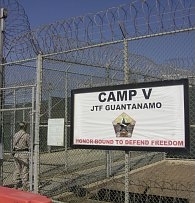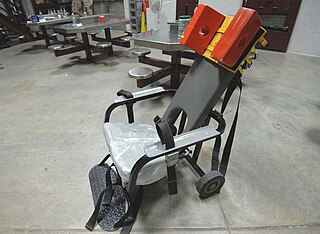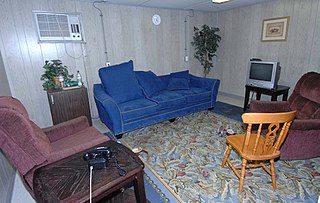
Camp Delta is a permanent American detainment camp at Guantanamo Bay that replaced the temporary facilities of Camp X-Ray. Its first facilities were built between 27 February and mid-April 2002 by Navy Seabees, Marine Engineers, and workers from Halliburton subsidiary Kellogg, Brown and Root. It is composed of detention camps 1 through 6, Camp Platinum, Camp Iguana, the Guantanamo psychiatric ward, Camp Echo and Camp No. The prisoners, referred to as detainees, have uncertain rights due to their location not on American soil. There are allegations of torture and abuse of prisoners.

Pul-e-Charkhi Prison, also known as the Afghan National Detention Facility, is a maximum security prison located next to the Ahmad Shah Baba Mina neighborhood in the eastern part of Kabul, Afghanistan. It has the capacity to house between 5,000 and 14,000 inmates, but as of February 2023 it only has between 2,000 and 2,500 inmates, most of whom have been arrested and convicted within the jurisdiction of Kabul Province. It is considered the country's largest prison.

The Guantanamo Bay detention camp is a United States military prison within Guantanamo Bay Naval Base, also referred to as Gitmo, on the coast of Guantánamo Bay in Cuba. Of the 780 people detained there since January 2002 when the military prison first opened after the September 11 attacks, 741 have been transferred elsewhere, 30 remain there, and 9 have died while in custody.

Musab Omar Ali Al Mudwani is a citizen of Yemen who was held in extrajudicial detention in the United States Guantanamo Bay detainment camps, in Cuba.
Taj Mohammed is a citizen of Afghanistan who was held in extrajudicial detention in the United States Guantanamo Bay detention camps, in Cuba. His Guantanamo Internment Serial Number was 902. Joint Task Force Guantanamo counter-terrorism analysts estimate Mohammed was born in 1981. He was repatriated in 2006.

Mohammad Ahmed Abdullah Saleh Al Hanashi was a citizen of Yemen, held in extrajudicial detention in the United States Guantanamo Bay detainment camps, in Cuba. Al Hanashi's Guantanamo Internment Serial Number was 78. The Department of Defense reports that Al Hanashi was born in February 1978, in Abyan, Yemen.
The United States Department of Defense (DOD) had stopped reporting Guantanamo suicide attempts in 2002. In mid-2002 the DoD changed the way they classified suicide attempts, and enumerated them under other acts of "self-injurious behavior".

Ayoub Murshid Ali Saleh is a citizen of Yemen who was held in extrajudicial detention in the United States Guantanamo Bay detainment camps, in Cuba. His Guantanamo Internment Serial Number is 836. The Department of Defense reports that he was born on April 29, 1978, in Usabee, Yemen.

Shawki Awad Balzuhair is a citizen of Yemen, held in extrajudicial detention in the United States Guantanamo Bay detainment camps, in Cuba. His detainee ID number is 838. The Department of Defense reports that Balzuhair was born on July 24, 1981, in Hadhramaut, Yemen.

Detainees held at the US-run Guantanamo Bay detention camp are typically issued one of two uniforms, either a white jumpsuit if the prisoner has been labeled "compliant", or an orange jumpsuit if the detainee has been labeled "non-compliant".
Inayatullah, born Hajji Nassim (1974–2011) was a citizen of Afghanistan who was arrested in 2007 and transferred that year to be held as an enemy combatant in the United States Guantanamo Bay detainment camps, in Cuba. His Guantanamo Internment Serial Number was 10028. Nassim was held in Guantanamo for 3 years, 8 months, and 22 days until his death by apparent suicide. The US claims he admitted being an al Qaeda leader, but Nassim denied this in numerous interrogation sessions. The US military claims he was headquartered in Zahedan, Iran. Nassim was the 19th captive to have been transferred to Guantanamo since September 6, 2006.

After the United States established the Guantanamo Bay detention camp at its naval base in Cuba, officials occasionally allowed Guantanamo captives' phone calls to their family. In 2008 the Joint Task Force Guantanamo that manages the camps developed rules regarding phone calls: all detainees who met certain conditions were allowed to make one call home per year.

Muhammed Murdi Issa Al Zahrani is a citizen of Saudi Arabia who was held in the United States's Guantanamo Bay detention camps, in Cuba from August 5, 2002, until November 22, 2014. His Guantanamo Internment Serial Number is 713. Joint Task Force Guantanamo counter-terrorism analysts estimate he was born in 1969, in Taif, Saudi Arabia.
Official sources show he died whilst at the facility.

Carol Rosenberg is a senior journalist at The New York Times. Long a military-affairs reporter at the Miami Herald, from January 2002 into 2019 she reported on the operation of the United States' Guantanamo Bay detention camps, at its naval base in Cuba. Her coverage of detention of captives at the Guantanamo Bay detention camp has been praised by her colleagues and legal scholars, and in 2010 she spoke about it by invitation at the National Press Club. Rosenberg had previously covered events in the Middle East. In 2011, she received the Robert F. Kennedy Journalism Award for her nearly decade of work on the Guantanamo Bay detention camp.
A number of incidents stemming from the September 11 attacks have raised questions about legality.
In 2003, a secret compound, known as Strawberry Fields, was constructed near the main Guantanamo Bay detention camps, in Cuba. In August 2010 reporters found that it had been constructed to hold CIA detainees classified as "high value". These were among the many men known as ghost detainees, as they were ultimately held for years for interrogation by the CIA in its secret prisons known as black sites at various places in Europe, the Mideast, and Asia, including Afghanistan.

Separate facilities exist to provide for Guantanamo detainees' medical care.











